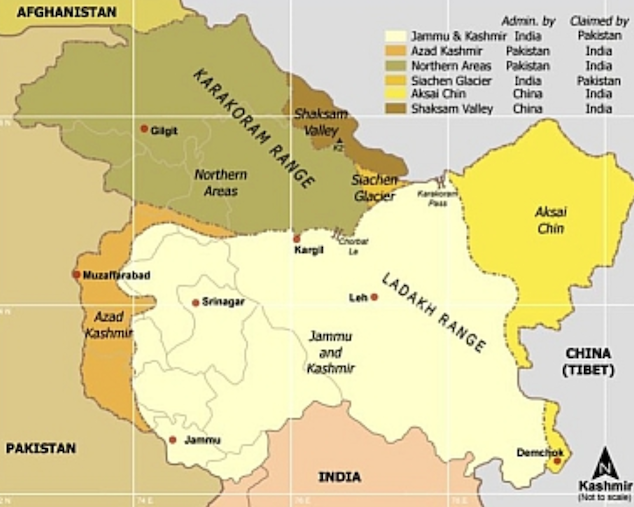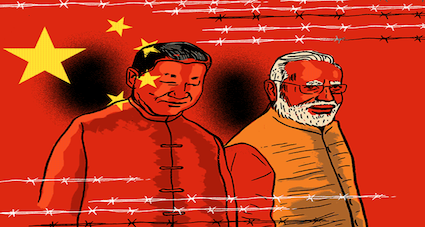(This is the second and final part on China. This exclusively looks at its relations with India. The first one concerned China’s horrible fate at the hands of West leading up to her liberation in 1949. It could be read here.—NewsBred)
India came into being in 1947; China in 1949.
The two victims of colonialists oozed warmth for each other.
Yet the wages of imperialism was to exact a terrible cost soon.
We trace our story from 1865 when a sub-assistant with the Survey of India, WH Johnson, proposed the Ladakh-Tibet/Xinjiang alignment.
Remember this was the time when neither India nor China had any control on its destiny.
Johnson’s proposal looked absurd on map. To join Karokaram with Demchok, he took a circuitous route which included the barren and cold Aksai Chin desert where “not a blade of grass grows”, as Pt Jawaharlal Nehru himself was to say.

Johnson, in doing so, was seeking favours of Maharaja of Jammu and Kashmir. He wasn’t disappointed as Maharaja, having gotten 18,000 sq km of uninhibited land free, made him the governor of Ladakh.
In 1899, another line was mooted: The Macartney-MacDonald Line. Now this one excluded most of Aksai Chin. Lord Curzon decided this was the border, never mind it still required China’s consent on historical grounds which the latter never gave.
This is more or less the same Line of Actual Control between the two nations on India’s north.
Britain though was still not sure. It proposed another border in the Karakoram range. The imperialists adjusted their borders as it suited them on their strategic perceptions.
However, the British had reverted to the Johnson line when they left in 1947, leaving Aksai Chin in India’s hands.
The British were similarly cavalier on the eastern sector. Here was a patch of land, known as Tawang tract which was considered by the British to be no-one’s land even though China was in full control of Tibet by 1910. But by September 1911, Britain decided to include the Tawang tract.
Britain called China and Tibet for Simla conference in October 1913. China was reluctant. Nevertheless, McMohan Line was the result. Tibet relinquished several hundred square miles to Britain, including Tawang. China was to repudiate it, saying Tibet wasn’t a sovereign state to sign the treaty.
Interestingly, Britain remained ambiguous on McMohan Line for decades. Tawang continued to be administered by Tibet. But in 1935, Britain revived it and two years later made McMohan Line the official boundary between British India and Tibet.
This was the position when British left. India had Tawang but did little to fortify its claim.
The Communists China meanwhile had backed its claim with action. Tibet was occupied.
Pt. Nehru’s government all this while was a mute spectator.
So much so that when China built a road connecting Tibet to Xinjiang across the Aksai Chin, New Delhi had no clue about it for several years!
India tried to make up for this lapse in the eastern sector.
It forcibly took Tawang in 1951.
In the north, it stuck to the Johnson Line, including Aksai Chin. China would have none of it. It had invested and built critical infrastructure by then. It rooted for McCartney/MacDonald Line.
Tension simmered below the peace on the surface. It turned worse when Dalai Lama fled and got political asylum in India in 1959.
Indian Media, as pro-West then as it is now, needled the government all along to fix China.
The Nehru regime tried to make up for its slumber by now adopting a “Forward Policy”, i.e. to establish posts in the disputed areas behind the Chinese line.
“Throw the Chinese out,” was the order by K. Raghuramiah, minister of state in defence ministry, in September 1962.
(This was China’s most isolated period of recent history. It clashed constantly with the West. It’s bond with Soviet Union was beginning to break up. It was recovering from a terrible famine of three years (1959-61). India, on the other hand, led the non-aligned bloc and was a prominent leader of the Third World.)
China retaliated by invading India in October, a month later.
They made lightning inroads, took over Tawang but left within weeks, withdrawing to pre-war position. Indian army was in full retreat when China unexpectedly declared a unilateral ceasefire.
China withdrew 20 kms behind the McMohan line, giving up Tawang too.
This is how things stand. China holds all the territory around its claim line in Ladakh. In the eastern sector, India holds most of the territory below the McMohan Line, including Tawang, now a district of Arunachal Pradesh.
xxx
So this is how things stand: In the north, India missed its moment when China constructed Xinjiang-Tibet road. Nehru woke up too late.
In the eastern sector it has Tawang for decades now, never mind China harping on it being a historical Tibetan land.
On the face of it, it shouldn’t stop the two Asian giants from embracing each other—it certainly is not worth a war.
We are talking of a pivotal moment in human history, concerning the lives of one third of world’s 8 billion people, a moment when West’ hegemony of 500 years could finally be over.
The other alternative is to let Westerners play its game of divide-and-rule, fuelled by toxic media.
Nothing would please them more than to have a Indo-China War.
Asia’s Century or history’s prisoners—the choice is stark.
Not that the leadership of two countries is unaware of what is at stake.
For all we know, they could be acting fools while BRICS and SCO take over the world.
It’s clear West is forcing a war on China.
The narrative swings from “expansionist” to “debt-trap-inducer” to “human rights” in Xinjiang to spy balloons and all that.
Taiwan is not trying to free itself from China—instead it’s claim is for whole of mainland!
There is a ring thrown around China through QUAD, AUKUS, US-Japan-Korea bloc and dozens of military bases.
All this while China is using trade—and not war—to grow.
Indeed, its West—and not China—which doesn’t want a peaceful Indo-Pacific.
Sooner than later, they would force the issue in this watery expanse—let there be no doubt.
India and China could either fight each other to death; or join hands for the prosperous future of its people.
All this for what? The border which the Britishers kept changing as it suited them?
(Concluded..)


